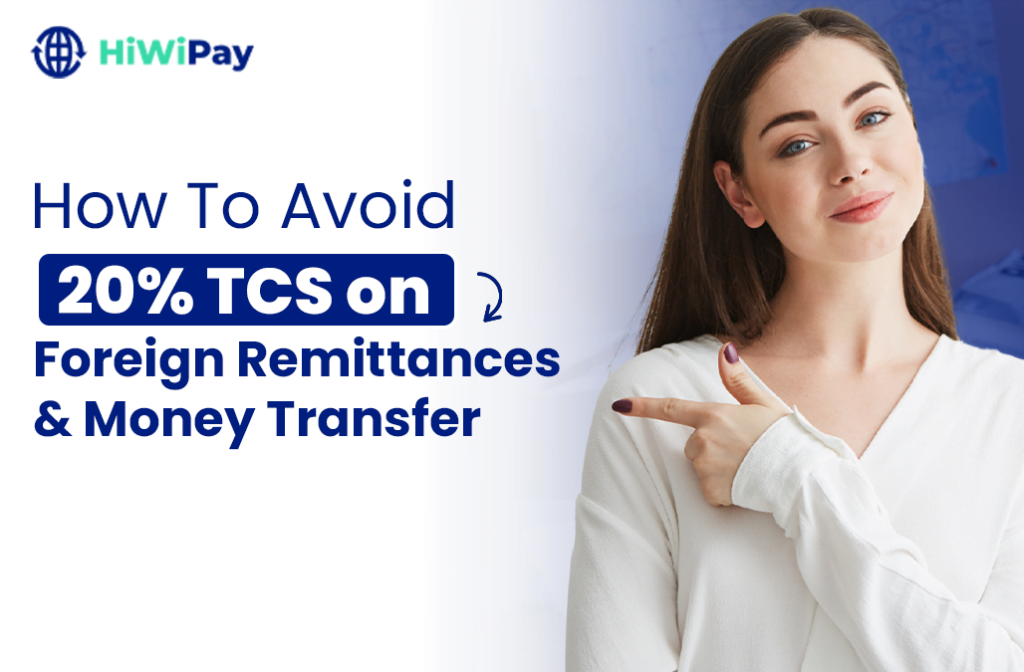Understanding the TCS on Foreign Remittance Transactions
TCS stands for “Tax Collected at Source”. It is a charge levied against the person by the authorised dealer or bank transferring money abroad. The main aim of this provision is to track remittances, create a link to the income tax returns of those making them, and prevent tax evasion.
Let’s understand this with an example for more clarity:
Suppose Mr. Sharma wants to send INR 10 lakhs to his daughter, who is studying in the United States. Under the new TCS rules effective from October 1, 2023, the following would apply:
- No TCS is levied on the first INR 7 lakhs of his remittance, as it is below the threshold.
- For the remaining INR 3 lakhs, if the remittance is made through an education loan, the TCS rate is 0.5%. This means Mr. Sharma would need to pay an additional INR 1,500 (0.5% of INR 3 lakhs) as TCS.
- If it is not through a loan, the TCS rate is 5%. In this case, Mr. Sharma would need to pay an additional INR 15,000 (5% of INR 3 lakhs) as TCS.
So, depending on whether the education is funded through a loan or not, Mr. Sharma would need to pay either INR 10,01,500 or INR 10,15,000 in total.
The example clearly shows that the TCS rates and rules vary depending on the purpose of the remittance and other factors. So, let’s move on to the applicable TCS rates on foreign remittances as per their purpose.
Read more: How to save on Paypal International Fees | Complete Guide
Applicable Rates for TCS on Foreign Remittance
Before 2023’s Union Budget, transactions over ₹7 lakhs were subject to a 5% TCS on overseas remittances made under the Liberalised Remittance Scheme (LRS). However, Mrs. Nirmala Sitharaman, India’s Finance Minister, suggested raising this tax in the budget from 5% to 20%. On October 1, 2023, the new rates were approved and put into effect.
The only exception for international money transfers for travel or medical expenses is that the TCS rate of 20% is now applied to all foreign remittance transactions, including international money transfers, investments, shopping, and the purchase of overseas trip packages.
Here are the new TCS rates on overseas outward remittances effective from October 1, 2023:
- TCS Rates for Overseas Outward Remittances (excluding medical and educational purposes)
| Amount of Remittances | TCS Rate |
| Below INR 7 Lakhs | Nil |
| INR 7 Lakhs or more | 20% |
- TCS Rates for Education Remittances
| Amount of Remittances | Purpose | TCS Rate |
| Below INR 7 Lakhs | Education | Nil |
| INR 7 Lakhs or more | Education Through Loan | 0.5% |
| INR 7 Lakhs or more | Education Not Through Loan | 5% |
- TCS Rates for Medical Remittances
| Amount of Remittances | Purpose | TCS Rate |
| Below INR 7 Lakhs | Medical Purposes | Nil |
| INR 7 Lakhs or more | Medical Purposes | 5% |
- TCS Rates for Overseas Packages
| Amount of Remittances | Purpose | TCS Rate |
| Below INR 7 Lakhs | Overseas Packages | 5% |
| INR 7 Lakhs or more | Overseas Packages | 20% |
- TCS Rates for Overseas Investments
| Amount of Remittances | Purpose | TCS Rate |
| Below INR 7 Lakhs | Overseas Investments | Nil |
| INR 7 Lakhs or more | Overseas Investments | 20% |
Note:
- Regardless of the reason for the remittances, TCS will be subject to the aggregate threshold amount of INR 7 lakhs. Depending on the reason for the transaction, TCS will be applied at various rates when this threshold is passed.
- Debit or forex card payments fall under the Liberalized Remittance Scheme (LRS). Only international credit card payments are exempt from TCS.
Key Ways To Avoid Paying The 20% TCS On Foreign Remittances
To avoid paying high TCS rates, consider the following:
Remittance below INR 7 lakh
You don’t have to pay TCS on money transferred overseas if the amount is below INR 7 lakh, so keep the transfer amount below INR 7 lakh to avoid 20% TCS. Remember that to avoid paying TCS this way, the total amount you send in a financial year should be below INR 7 lakh. You can use this method irrespective of your purpose of sending money abroad and the method of transferring money.
Education or Medical Treatment Purposes
Rest assured that you won’t have to pay 20% TCS when sending money abroad for education or medical treatment purposes as the TCS rate for these is really low as per the new TCS rates on overseas outward remittances, effective from October 1, 2023.
To avoid paying TCS when sending money abroad to your loved ones for education or medical treatment purposes, either you can send it below INR 7 lakh to avoid it altogether or consider sending money in the following ways to reduce the TCS rate:
- For education purposes, send money above INR 7 lakhs but fund it through a loan; this way, the TCS rate will be 0.5% only. If you send it without funding it through a loan, the TCS rate is 5%.
- For medical treatment purposes, you can send money above INR 7 lakhs at a 5% TCS rate.
Using credit cards
You can use your international credit card to transfer money abroad to avoid paying 20% TCS as they are not considered to be a part of the Liberalised Remittance Scheme (LRS), and therefore, are exempt from TCS. This applies only as long as the amount does not exceed INR 7 lakh in a financial year.
Note that credit cards might be included as a part of the Liberalised Remittance Scheme (LRS), meaning you will have to pay TCS when transferring money abroad through it in the future. This is because initially, the Finance Ministry had included credit cards as a part of the Liberalised Remittance Scheme (LRS), but the Government decided to postpone this as per its 16th May 2023 e-gazette notification. They postponed it to give banks and card networks adequate time to make arrangements for the necessary IT-based solutions.
Utilise a non-resident Indian (NRI) account
An NRI account is a bank account opened in India in the name of an NRI. It is usually used to manage payments earned in India. As per the Income Tax Act, if you use an NRI account to transfer money to your non-residential external (NRE) or foreign accounts, TCS will not apply.
This implies that non-resident Indians (NRIs) can simply use their account to transfer their Indian earnings, such as pensions, dividends, salaries, rent, investments, profits from enterprises that are allowed to be repatriated, distributions from any kind of deposit, etc., without having to pay TCS.
Also, a foreign currency exchange (Forex) dealer can waive TCS for remittances when you transfer money through them.
Avoid packaging of the trip
If the sum for an overseas tour travel package is up to INR 7 Lakh, a TCS of 5% will be applied. After this point, a 20% TCS will be applied. Separate bookings and payments can help avoid this TCS. For example, if you purchase your overseas flight tickets, hotels, and other costs separately, you won’t pay any TCS as long as the company selling such tickets stays with you while you are in India. However, TCS regulations will apply if you are in India and making payments in a foreign currency for your plane tickets and hotel reservations.
Get a zero forex international debit card
A zero forex international debit card is a bank-issued debit card that allows you to conduct foreign currency transactions without incurring extra foreign exchange costs. By using a zero forex international debit card, you can potentially save on the TCS that applies to foreign remittances exceeding INR 7 lakh in a financial year under Indian tax laws.
Please note that while these cards can offer significant benefits, they may also have certain limitations or fees, such as ATM withdrawal fees or annual fees. Do check the terms and conditions and understand the fee structure before getting such a card.
What is the difference between TCS and TDS?
Meaning
- TDS stands for Tax Deducted at Source. It is collected by the government on the income earned.
- TCS stands for Tax Collected at Source. It is collected by the government at the time of payment of imported goods or services.
Application
- TDS is applicable to various types of income or services, such as rent, commission, interest, rent, salaries, brokerage and more.
- TCS only applies to specific imported goods or services such as selling toll tickets, forest products, cars, tendu leaves, minerals, liquor, timber, scrap, etc.
Liability
- Liability for TDS falls on the individual or company making the payment.
- Liability for TCS falls on the individual or business selling the goods or services.
Certificates
- There are two primary types of TDS certificates: Form 16 and Form 16A, which are issued to individuals who have deducted tax on payments made to others.
- There is only one certificate for TCS: Form 27D issued to the purchaser of the goods.
Regulations
- TDS is governed by the Income Tax Act, 1961.
- TCS is governed by the Finance Act, 1994.
Examples of TDS and TCS:
- TDS: Suppose you are an employee at a company, and your annual salary is INR 6,00,000. As per the Indian tax laws, if an employee’s salary is more than INR 2,50,000 per annum, the employer is required to deduct TDS. The rate of TDS deduction depends on the income tax slab under which you fall. For simplicity, let’s assume it is 10%. So, your employer will deduct INR 60,000 (10% of INR 6,00,000) as TDS, and you will receive INR 5,40,000 as your net salary for the year.
- TCS: Suppose you buy a car worth INR 12,00,000 from a car dealer. As per the Indian tax laws, if the value of the car is more than INR 10,00,000, the seller is required to collect TCS. The rate of TCS is 1% for a car. So, the car dealer will collect INR 12,000 (1% of INR 12,00,000) as TCS. Therefore, the total amount you pay to the dealer will be INR 12,12,000 (INR 12,00,000 + INR 12,000).
FAQs on TCS On Foreign Remittances
What is TCS on foreign remittance?
TCS is a charge levied against the person by the authorised dealer or bank transferring money abroad.
Who is eligible for a TCS refund?
A person is eligible for a TCS refund under the following conditions:
- If your total TCS amount is higher than your tax liability for the year.
- If you have filled your ITR return on time.
- If you have supporting documents for remittances like bank statements and forex card statements.
- If you have provided accurate information in the ITR.
How to Claim TCS while filing an ITR?
Claiming TCS while filing ITR involves the following steps:
- Collect the relevant documents, such as the TCS certificate (Form 27D) provided by the collected.
- Before filing your ITR, verify Form 26AS, which is a consolidated tax statement that provides details of the taxes deducted on your behalf.
- File your ITR for the year.
- Claim TCS refund in ITR if you have paid more TCS than your actual tax liability by filling out the relevant sections of the ITR form and providing supporting documents.
How much money can you send overseas under LRS in a year?
As per the Liberalised Remittance Scheme (LRS) regulations, you can send up to USD 250,000 (INR 20,682,750) per financial year (April-March). If you need to send more money than USD 250,000 (INR 20,682,750) per financial year (April-March), you must contact the RBI for approval.
How will TCS apply for remitting money for education abroad?
As per the Liberalised Remittance Scheme (LRS) regulations, here’s how TCS applies to educational expenses:
| Amount of Remittances | Purpose | TCS Rate |
| Below INR 7 Lakhs | Education | Nil |
| INR 7 Lakhs or more | Education Through Loan | 0.5% |
| INR 7 Lakhs or more | Education Not Through Loan | 5% |
References
BS Web Team. “When and How Can I Claim a TCS Refund on Foreign Remittance?” @Bsindia, Business Standard, 7 June 2023, www.business-standard.com/finance/personal-finance/when-and-how-can-i-claim-a-tcs-refund-on-foreign-remittance-123060700543_1.html. Accessed 1 Apr. 2024.
CA Dr. Dilip Satbhai. “New TCS Rule from 1st October 2023: Tips to Reduce TCS on Foreign Trip.” TaxGuru, 26 Sept. 2023, taxguru.in/income-tax/tcs-rule-1st-october-2023-tips-reduce-tcs-foreign-trip.html. Accessed 1 Apr. 2024.
Chopra, CA Mamta. “New 20% TCS on Foreign Remittance from 01.10.2023 Simplified.” TaxGuru, 30 Sept. 2023, taxguru.in/income-tax/new-20-percent-tcs-foreign-remittance-oct-2023-simplified.html#:~:text=As%20of%20this%20date%2C%20all%20overseas%20outward%20remittances%2C. Accessed 1 Apr. 2024.
“Liberalised Remittance Scheme FAQs.” Rbi.org.in, 6 Apr. 2023, www.rbi.org.in/Scripts/FAQView.aspx?Id=115#Q9. Accessed 1 Apr. 2024.
“Overview on Eligibility for Claiming a Refund of TCS | IFCCL.” India Financial Consultancy Corporation, 16 Mar. 2024, www.caindelhiindia.com/blog/claiming-a-refund-of-tcs/. Accessed 1 Apr. 2024.
Ray, Anulekha. “3 Ways to Avoid the 20% TCS on Overseas Tour Packages Effective July 1, 2023.” The Economic Times, Economic Times, 27 June 2023, economictimes.indiatimes.com/wealth/tax/3-ways-to-avoid-the-20-tcs-on-overseas-tour-packages-or-international-trip-effective-july-1-2023/printarticle/101023697.cms. Accessed 1 Apr. 2024.
—. “No TCS on Foreign Remittances of up to Rs 7 Lakh, Credit Card Spending Overseas; Higher Rates to Kick in from October 1.” The Economic Times, 6 July 2023, economictimes.indiatimes.com/wealth/tax/new-tcs-rule-to-come-into-effect-from-october-1-2023-finance-ministry/articleshow/101345956.cms?from=mdr. Accessed 1 Apr. 2024.
Shetty, Surabhi. “How to Avoid 20% TCS on Foreign Remittances & Money Transfer.” Www.moneyhop.co, 10 Oct. 2023, www.moneyhop.co/blog/how-to-avoid-tcs-on-foreign-transfer. Accessed 1 Apr. 2024.
Surana, Ektha. “Difference between TDS and TCS.” Cleartax, 22 Jan. 2024, cleartax.in/s/difference-between-tds-and-tcs. Accessed 1 Apr. 2024.
“Tax Collected at Source (TCS) – Rates, Payment, and Exemption.” Cleartax, 1 Mar. 2024, cleartax.in/s/tax-collected-source. Accessed 1 Apr. 2024.








